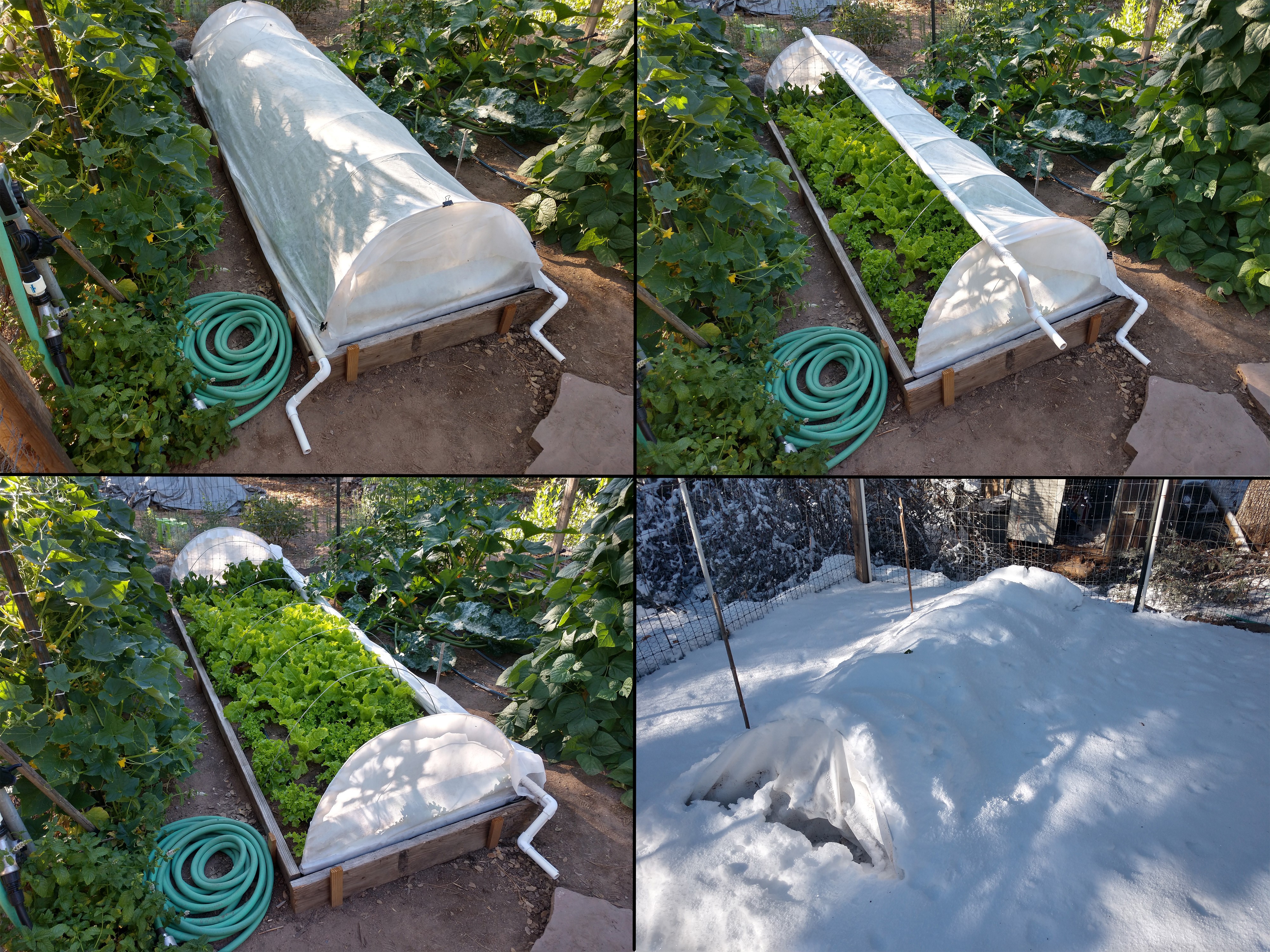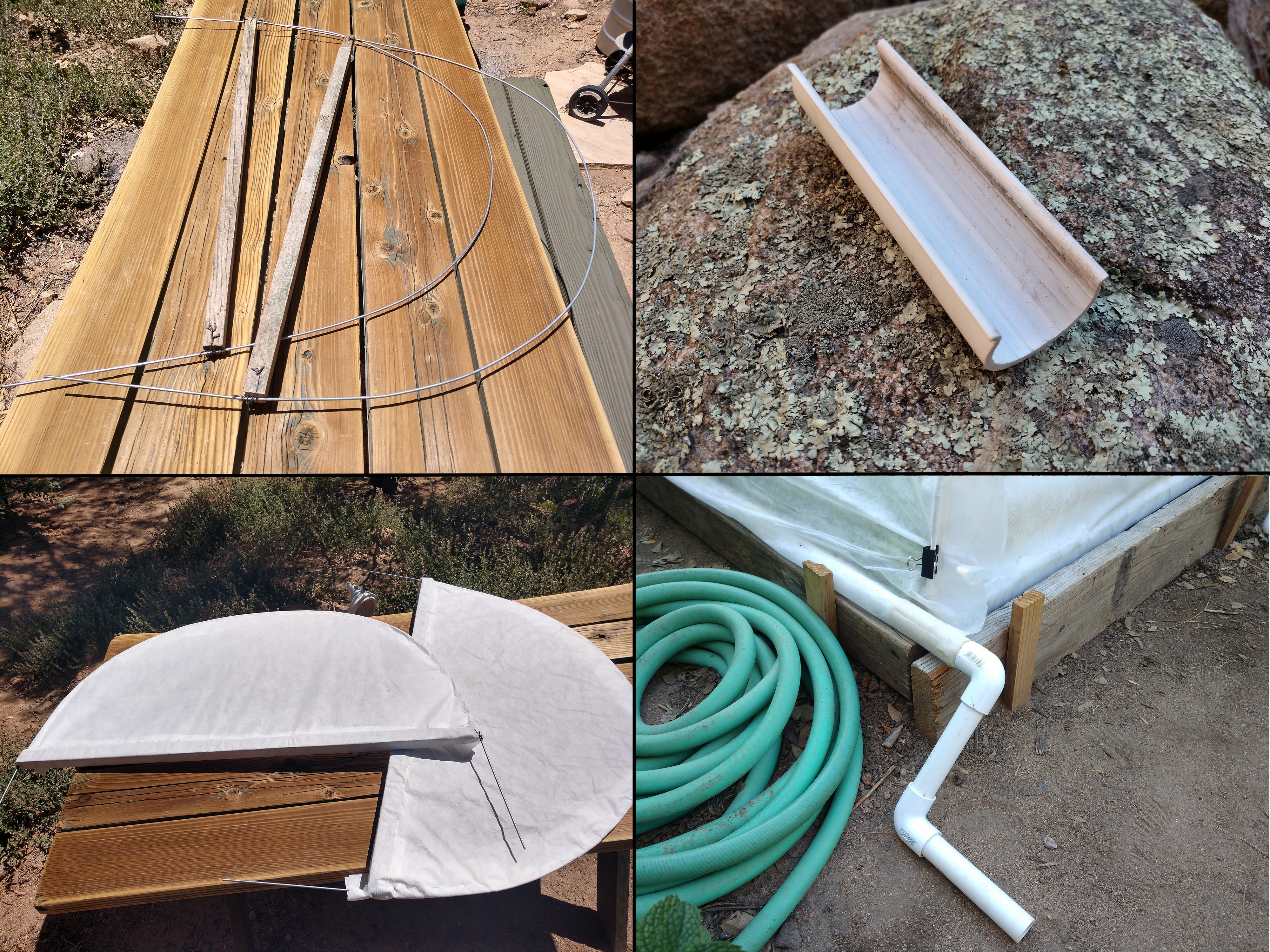 Low Tunnels for Home Gardens - August 19, 2020 Jeff Schalau, Agent, Agriculture & Natural Resources University of Arizona Cooperative Extension, Yavapai County I’ve been experimenting with “season extension” in our home vegetable garden for a few years. My goal is to grow and harvest lettuce year-round in my Prescott, AZ garden using season extension. Season extension is any method that allows a crop to be grown and/or harvested beyond its normal outdoor growing season and harvesting time frame. At first, I just used floating row cover laid out over the crop and secured around the edges with 2x2s. It worked well, but sometimes the snow would sit on it for extended periods which seemed to suppress growth. After seeing how some local farms produce crops in the winter months, I started experimenting with “low tunnels”. Low tunnels can be of various heights and covered mainly with three types of plastic materials: perforated or slit plastic film, spun-bonded fabrics, and insect nets, depending on the purpose of their use. They are usually under 3-4 feet high and supported with hoops. They do add to production costs, but home gardeners are often more interested in fresh homegrown food and simple technology. My low tunnels have been successful using two weights of spun bonded fabric (also called floating row cover). Floating row cover is breathable for air exchange and allows some water to get through too. A heavy weight (AG-50) is used in winter months and a light weight (AG-19) in summer months. There is also a lighter AG-15 used for insect barriers. The “AG” is a brand name (Agribon) and other manufacturers make similar row cover products. Row cover is also available in various dimensions. An 83” width is perfect for the low tunnel design described here. Hoops are bent from 76” long pieces of 10 gauge galvanized steel rods. The environment inside the low tunnel will be warmer in the winter and more humid in the when the temperatures are above freezing. I have noticed improved germination and growth under the AG-19 even during the summer. The low tunnel also requires less irrigation. Light may be reduced under the row cover, but for most vegetable crops, Arizona has plenty of light to satisfy leafy greens. The resulting lettuce is certainly faster growing and more succulent than crops grown without protection. I arrived on my design by trial and error. My first low tunnel did not have ends – I simply covered the hoops and held it down with 2x2s and rocks (market growers often use sandbags). At first, I did not construct a formal raised bed – the row cover rested on soil. Recently I added temporary 2x6 boards to form a low raised bed (3 ft x 10 ft) held in place by wooden stakes. I also constructed 3-foot-wide end hoops that had AG-50 sewn on. The end hoops have a 1x1 board tied to the hoop with tie wire to make them sturdy and sealed at the soil level. Drip tape is also part of the bed and is used when we don’t have freezing temperatures. I cut a 10’ x 83” piece of row cover for the tunnel. The row cover is attached to two 10’ sections of ¾” PVC (with handles) using PVC snap clamps (a specialty product available from farm suppliers). I set this aside until the bed has been amended and planted. For lettuce crops, I amend the soil with compost, alfalfa cubes, and phosphorus fertilizer. Lettuce thrives on available nitrogen which is supplied by the compost and alfalfa cubes. I then place the 2x6 sides and secure them with wooden stakes. I give the bed a final raking: leveling and tamping the amended soil with an iron rake to make a firm seedbed. Then I direct seed several lettuce varieties. After planting, the drip tape and hoops are placed. After germination, we transplant the seedlings to the proper spacing (6-8”). We grow mostly leaf lettuce, but like some of the butterhead varieties too. After an initial irrigation, the row cover/PVC is placed over the hoops and secured with three binder clips on each end. The PVC seals tightly against the 2x6s and provides an enhanced environment while precluding many insects and mammals that can negotiate fences (woodrats). I have included several photos, a materials list, and multiple links that further describe low tunnels and their varied uses below. Naming of companies or products is neither meant to imply endorsement by the author nor criticism of similar companies or products not mentioned. You can follow the Backyard Gardener on Twitter – use the link on the BYG website. If you have other gardening questions, email the Master Gardener Help Desk in Prescott (prescottmg@gmail.com) or Camp Verde (verdevalleymg@gmail.com) and be sure to include your name, location, and phone number. Find past Backyard Gardener columns or provide feedback at the Backyard Gardener web site: https://cals.arizona.edu/yavapai/anr/hort/byg/. Images  Low tunnel used for year-round lettuce production. When closed, it offers frost, insect, and limited animal protection (upper left). It is opened by removing two of the binder clips at each end and turning the handle (upper right) and left open during warm days (lower left) and closed each night. The AG-50 row cover is used in winter and is usually left in place except to irrigate (lower right). Photos provided by Jeff Schalau, University of Arizona.
Low tunnel used for year-round lettuce production. When closed, it offers frost, insect, and limited animal protection (upper left). It is opened by removing two of the binder clips at each end and turning the handle (upper right) and left open during warm days (lower left) and closed each night. The AG-50 row cover is used in winter and is usually left in place except to irrigate (lower right). Photos provided by Jeff Schalau, University of Arizona. End hoops are built from 1x1s, a wire hoop, row cover (loosely sewn on), and tie wire to hold the wood in place (upper and lower left). PVC snap clamps are handy for attaching row cover to the 10’ lengths of PVC pipe (upper right) and can also be used for bird netting and other garden projects. To open, remove two binder clips from each end and turn the crank. Photos provided by Jeff Schalau, University of Arizona.
End hoops are built from 1x1s, a wire hoop, row cover (loosely sewn on), and tie wire to hold the wood in place (upper and lower left). PVC snap clamps are handy for attaching row cover to the 10’ lengths of PVC pipe (upper right) and can also be used for bird netting and other garden projects. To open, remove two binder clips from each end and turn the crank. Photos provided by Jeff Schalau, University of Arizona.Additional Resources Low Tunnel Materials List, Jeff Schalau, University of Arizona Coopertive Extension cals.arizona.edu/yavapai/anr/hort/byg/archive/10footlowtunnelmatls.pdf Low Tunnels in Vegetable Crops: Beyond Season Extension, Virginia Cooperative Extension cdn.sare.org/wp-content/uploads/20181008104653/HORT-291.pdf Season Extension with Low Tunnels, Maine Organic Gardeners Association www.mofga.org/Publications/Articles-for-Reprinting/Season-Extension-With-Low-Tunnels Low Cost Season Extension, Michigan State University Extension www.msunorthfarm.org/uploads/3/8/2/8/38288527/the_north_farm_-_low_cost_season_extension.compressed.pdf |